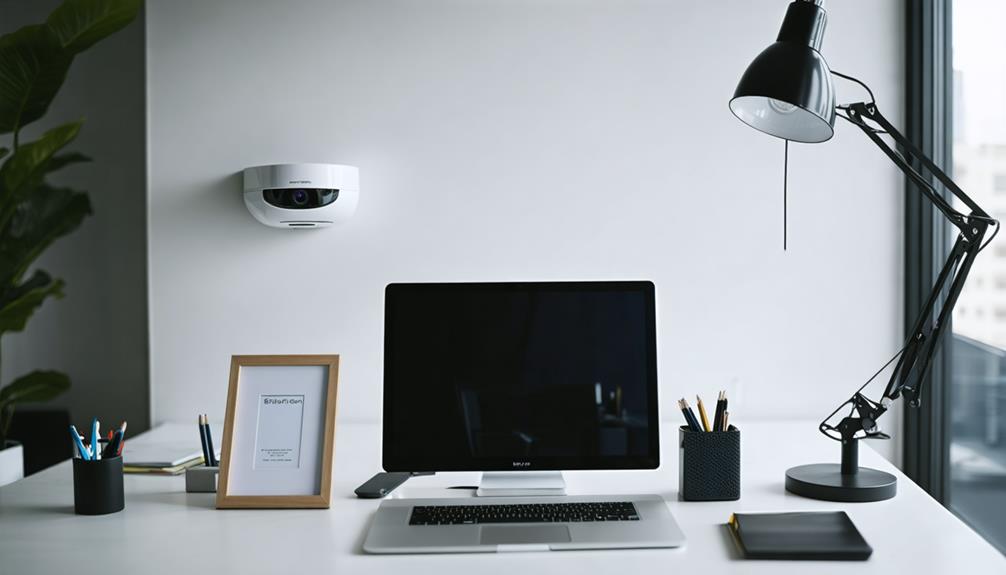
Brainstorm Security Shop

For Orders Over $199

On Any Of Our Products

Details On Refund Page
When you consider installing office hidden cameras, you might think about the benefits of increased security and improved productivity. However, it’s crucial to weigh these advantages against the potential legal and ethical pitfalls that come with surveillance. Are you prepared to navigate the fine line between ensuring safety and respecting employee privacy? The decisions you make regarding camera placement and type can significantly impact the work environment. Understanding these complexities can help you create a more secure yet respectful atmosphere—so what should you prioritize first?
Office hidden cameras serve multiple purposes, primarily focusing on security and accountability. When you implement these devices, you enhance workplace monitoring, ensuring a safer environment for everyone. With the help of surveillance technology, you can deter potential misconduct or theft, as employees are more likely to follow rules when they know they’re being watched.
These cameras also play a vital role in documenting incidents. If any disputes arise, recorded footage can help clarify what actually happened, providing you with valuable evidence. This can be particularly important in resolving conflicts between employees or addressing customer complaints.
Moreover, hidden cameras can assist in monitoring employee productivity. By observing work habits, you can identify areas where performance may lag and address them accordingly. This proactive approach can lead to improved efficiency and a more engaged workforce.
When considering the installation of hidden cameras in the workplace, it’s crucial to navigate the complex landscape of legal considerations and regulations. First, you need to understand that laws around surveillance vary significantly by location. In many jurisdictions, you must obtain employee consent before placing hidden cameras in areas where they expect privacy, such as restrooms or break rooms. Not adhering to these consent requirements can lead to severe legal repercussions.
Additionally, it’s vital to ensure your workplace policies clearly outline the use of surveillance. Establish guidelines that specify where cameras will be located, the purpose of the surveillance, and how the footage will be used. Communicating these policies to your employees promotes transparency and helps foster trust within your team.
You should also be aware of any specific state or federal regulations that may apply, as they can dictate the extent of your surveillance capabilities. Regularly review and update your policies to stay compliant with any changes in legislation. By carefully considering these legal aspects, you can implement hidden cameras in a way that respects your employees’ rights while still achieving your security objectives.
When you consider the use of hidden cameras in the office, you must weigh the balance between privacy and security. Surveillance can create an atmosphere of distrust, affecting employee morale and their perception of a supportive workplace.
How do you ensure that the need for safety doesn’t infringe on personal privacy?
Navigating the delicate balance between privacy and security can feel overwhelming, especially in workplaces where surveillance technologies are becoming increasingly common. You might find yourself questioning the necessity of workplace surveillance while grappling with privacy concerns. Striking a balance is crucial to maintaining a healthy work environment.
| Aspect | Pros | Cons |
|---|---|---|
| Security | Deters misconduct and theft | Can create a culture of mistrust |
| Employee Privacy | Encourages open communication | May lead to anxiety or discomfort |
| Company Image | Enhances accountability | Risks negative public perception |
When you weigh these factors, it’s clear that prioritizing security can sometimes infringe upon individual privacy. While it’s vital to protect company assets and ensure a safe work environment, you must also consider the ethical implications of constant monitoring. Balancing these elements requires thoughtful policies that respect employee privacy while also addressing legitimate security needs. Ultimately, fostering an atmosphere of trust and transparency is essential as you navigate this complex landscape.
Surveillance in the workplace can significantly impact employee trust and morale, often leading to unintended consequences. When you implement hidden cameras, your employees might start feeling like they’re constantly being watched, which can create trust issues. Instead of fostering a culture of transparency, you may inadvertently build an environment of suspicion and anxiety.
As employees become aware of surveillance, their sense of autonomy can diminish. They might feel their every move is monitored, leading to a morale impact that can stifle creativity and collaboration. Individuals may become less willing to share ideas or take risks, fearing that their actions could be misinterpreted or scrutinized.
Moreover, if employees perceive that they’re not trusted, it can create a divide between management and staff. This lack of trust can result in decreased job satisfaction, increased turnover, and a toxic work environment.
To maintain a healthy workplace, it’s crucial to balance security needs with respect for privacy. Open communication about the reasons for surveillance and involving employees in discussions can help mitigate trust issues and ultimately boost morale. Remember, a trusted employee is often a motivated employee.
When it comes to choosing the right office hidden camera, understanding the different types available is crucial.
You’ll want to consider key features like resolution, field of view, and storage options to ensure you get the best fit for your needs.
Let’s explore these factors to help you make an informed decision.
Choosing the right camera for your office can feel overwhelming, especially with the variety of options available. You want to ensure you select a camera that fits your needs for covert placement and effective monitoring options. Here’s a quick overview of three common camera types that might work for you:
When selecting a camera, think about where you’ll place it and what you want to monitor. Each type offers unique advantages, so consider your specific needs to make the best choice for your office environment. Remember, the right camera can enhance security and ensure peace of mind.
As you explore options for office cameras, understanding key features can significantly impact your decision. First and foremost, consider camera resolution. A higher resolution means clearer images, which is crucial for identifying faces or details in your workspace. Aim for at least 1080p HD resolution for optimal clarity.
Another essential feature to look for is remote access. With this capability, you’ll be able to monitor your office in real-time from anywhere, using your smartphone or laptop. This flexibility not only enhances security but also allows you to respond promptly to any incidents.
Additionally, think about the camera’s field of view. A wider angle can cover more area, reducing the number of cameras you need.
Night vision is another feature worth considering, especially if your office operates after hours.
Installing hidden cameras in an office requires careful planning to ensure effectiveness and compliance with legal standards. You’ll want to focus on several key factors to make the most of your surveillance system.
Don’t forget the importance of maintenance tips. Regularly check camera angles and functionality to ensure they operate as intended. Keeping your cameras in good working order will provide peace of mind and ensure compliance with privacy laws. By following these best practices, you can create a secure environment that protects your business interests.
While installing hidden cameras enhances security, it’s vital to consider how this impacts employee privacy. You need to strike a balance between creating a safe work environment and respecting individual rights. Surveillance ethics play a critical role in this conversation. It’s essential to be transparent about where cameras are placed and the purpose behind them.
When employees know they’re being monitored, it can lead to a more secure atmosphere; however, it can also create tension and mistrust if not handled properly.
Addressing privacy concerns is crucial. Make sure you comply with local laws regarding surveillance and inform your team about the monitoring system in place. This openness can help mitigate fears and foster a sense of respect.
You might also consider limiting camera placement to common areas rather than private spaces to further alleviate concerns.
Ultimately, by being mindful of surveillance ethics and prioritizing privacy concerns, you can create a workplace that feels secure yet respectful. This balance not only protects your business but also nurtures a positive work environment where employees feel valued and trusted.
You might think reducing employee theft is crucial, but consider privacy concerns and ethical implications. Balancing security measures with respect for personal space is essential to maintain trust and a positive workplace environment.
When considering types of hidden cameras for offices, you’ll want options that allow for covert monitoring and effective workplace surveillance. Look for models that blend seamlessly into the environment while providing clear, reliable footage.
To maintain employee trust with surveillance, prioritize transparency about your intentions. Balance employee privacy with workplace productivity, and engage in open discussions about surveillance ethics. Building trust fosters a positive environment, enhancing overall morale and collaboration.
Yes, there are specific laws regarding recording in break rooms. You need to consider privacy concerns and workplace regulations, ensuring you obtain employee consent. Familiarize yourself with local video monitoring laws to stay compliant.
You can use hidden cameras in open office spaces, but privacy concerns arise. While they may enhance the effectiveness of deterrence against misconduct, you must consider employees’ rights and applicable laws before proceeding.
